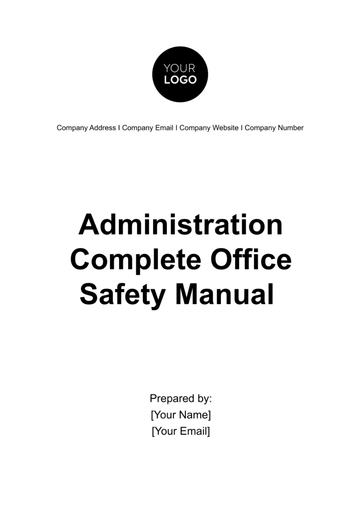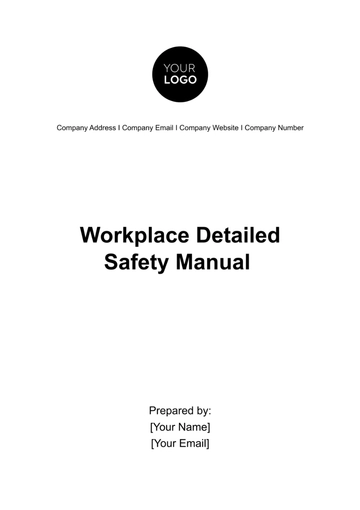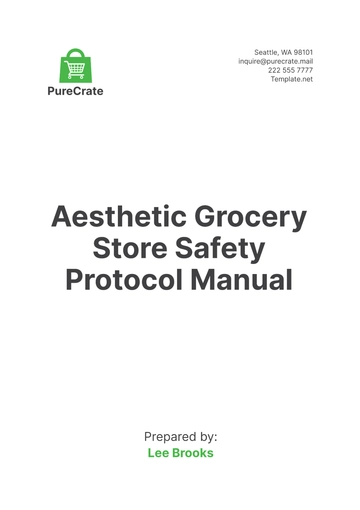Free Safety Manual

I. Introduction
The [YOUR COMPANY NAME] Safety Manual is designed to ensure the safety and well-being of all employees while they are on the premises of [YOUR COMPANY NAME]. This manual outlines the policies, procedures, and guidelines that must be followed by all employees to maintain a safe working environment. Safety is our top priority, and it is essential that every member of [YOUR COMPANY NAME] takes responsibility for their own safety and the safety of their colleagues.
II. Responsibilities
[YOUR COMPANY NAME]'s Commitment to Safety: [YOUR COMPANY NAME] is committed to providing a safe and healthy work environment for all employees. Management will ensure that necessary resources are provided to implement and maintain safety protocols. Regular safety inspections and audits will be conducted to identify and mitigate potential hazards.
[YOUR DEPARTMENT]'s Responsibilities: [YOUR DEPARTMENT] is responsible for ensuring that all employees are properly trained in safety procedures relevant to their roles. Supervisors must enforce safety policies and take appropriate action to address any safety concerns promptly. Reporting any safety hazards or incidents immediately to the designated safety officer.
III. Safety Procedures
Emergency Procedures: In the event of an emergency such as a fire or natural disaster, [YOUR DEPARTMENT]'s designated evacuation routes must be followed promptly. Employees should familiarize themselves with the location of emergency exits, fire extinguishers, and first aid kits in their work area.
Personal Protective Equipment (PPE): Employees are required to wear appropriate PPE, including helmets, safety goggles, gloves, and steel-toed boots, when working in hazardous environments. Regular inspection and maintenance of PPE should be conducted to ensure effectiveness.
IV. Incident Reporting
Reporting Procedures: All accidents, injuries, near misses, or hazardous conditions must be reported to [YOUR DEPARTMENT] immediately, regardless of severity. Incident reports should be completed accurately and promptly to document the details of the event.
Investigation and Follow-Up: [YOUR DEPARTMENT] will conduct a thorough investigation of all reported incidents to determine the root cause and implement corrective actions. Follow-up measures will be taken to prevent similar incidents from occurring in the future.
V. Training and Education
Safety Training Programs: All employees will receive comprehensive safety training upon commencement of employment, including general safety practices and job-specific hazards. Refresher training will be provided periodically to reinforce safety awareness and promote a culture of safety.
Safety Meetings and Communication: Regular safety meetings will be held to discuss safety topics, address concerns, and reinforce safety policies. Communication channels will be established to ensure that important safety information reaches all employees promptly.
VI. Safety Inspections
Regular Inspections:
Scheduled safety inspections will be conducted by [YOUR DEPARTMENT] to identify potential hazards and ensure compliance with safety regulations.
Inspections will encompass all areas of the workplace, including offices, production facilities, and outdoor spaces.
Documentation and Reporting:
Inspection findings will be documented in detail, including observed hazards, recommended corrective actions, and follow-up measures.
Reports will be submitted to management for review and action, and copies will be kept on file for reference.
VII. Hazard Communication
Identification of Hazards:
All hazardous substances and materials present in the workplace will be clearly labeled with appropriate warning signs and symbols.
Safety data sheets (SDS) will be accessible to employees for reference, providing information on the safe handling and storage of hazardous materials.
Training and Awareness:
Employees will receive training on the recognition of hazardous substances and the proper procedures for handling, storing, and disposing of them safely.
Informational signage and labels will be used to communicate hazards effectively throughout the workplace.
VIII. Safety Equipment and Machinery
Equipment Maintenance:
All machinery and equipment will undergo regular maintenance and inspection to ensure safe operation.
Defective or malfunctioning equipment must be taken out of service immediately and reported to [YOUR DEPARTMENT] for repair or replacement.
Safe Operating Procedures:
Employees must be trained in the safe operation of all equipment and machinery relevant to their job duties.
Standard operating procedures (SOPs) will be established and followed to minimize the risk of accidents and injuries.
IX. Health and Wellness
Promotion of Health:
[YOUR COMPANY NAME] is committed to promoting employee health and wellness through initiatives such as wellness programs, ergonomic assessments, and access to health resources.
Employees are encouraged to take breaks, maintain proper posture, and engage in physical activity to reduce the risk of musculoskeletal disorders and other health issues.
Employee Assistance Programs (EAP):
Confidential counseling services and support will be available to employees through the EAP to address personal or work-related concerns affecting their well-being.
[YOUR DEPARTMENT] will facilitate access to EAP resources and provide guidance on seeking assistance when needed.
X. Conclusion
Safety is everyone's responsibility at [YOUR COMPANY NAME]. By adhering to the policies and procedures outlined in this manual, we can create a safe and healthy work environment for all employees. Together, we can prevent accidents and injuries and ensure the well-being of everyone in our organization.
- 100% Customizable, free editor
- Access 1 Million+ Templates, photo’s & graphics
- Download or share as a template
- Click and replace photos, graphics, text, backgrounds
- Resize, crop, AI write & more
- Access advanced editor
Introducing the Safety Manual Template by Template.net: Your ultimate solution for crafting comprehensive safety guidelines. This editable and customizable template, accessible via our Ai Editor Tool, empowers you to tailor safety protocols effortlessly. From workplace standards to emergency procedures, streamline your safety manual creation process with ease.





























